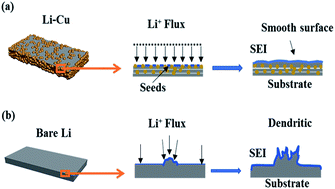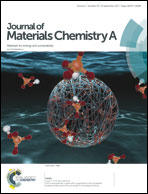Pre-planted nucleation seeds for rechargeable metallic lithium anodes†
Abstract
Metallic lithium is one of the most favorable anode materials for next-generation energy storage systems owing to its high theoretical capacity, low density and lowest negative electrochemical potential. Despite these attractive advantages, problems induced by uneven Li deposition and volume expansion have hindered the practical application of Li-metal anodes. Among numerous efforts to stabilize metallic lithium anodes, regulating lithium deposition at the nucleation stage is challenging. Herein, we propose a strategy of pre-planting nucleation seeds to inhibit the uneven dendrite growth of metallic lithium. The nucleation and growth of lithium dendrites can be efficiently regulated by adequate heterogeneous nucleation seeds while the lamellar structure can accommodate the volume change to some extent. Benefiting from these two aspects, the Li–Cu hybrid exhibits superior electrochemical performance in terms of lower over-potential, superior cycle stability with a flatter voltage plateau and prolonged lifespan, and a high specific capacity of 2023 mA h g−1. On this basis, electrochemical tests on full-cells with LiFePO4 as the cathode also confirm the effectiveness of the Li–Cu hybrid anode which shows highly stable cycling performance and excellent capacity retention.



 Please wait while we load your content...
Please wait while we load your content...